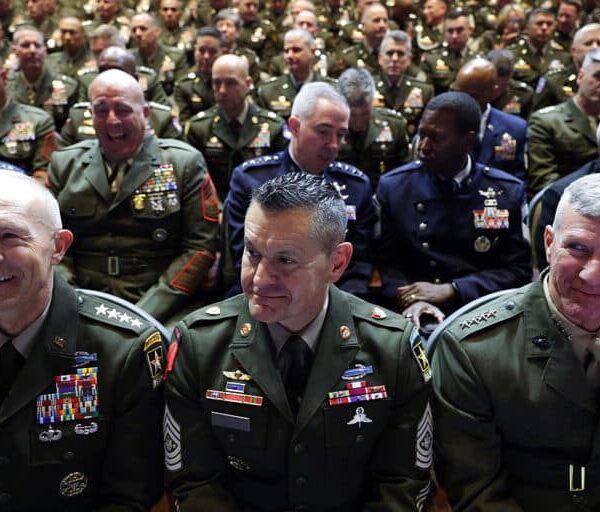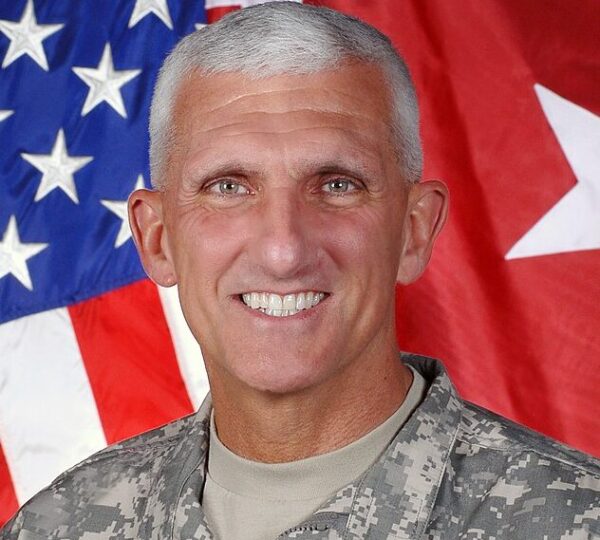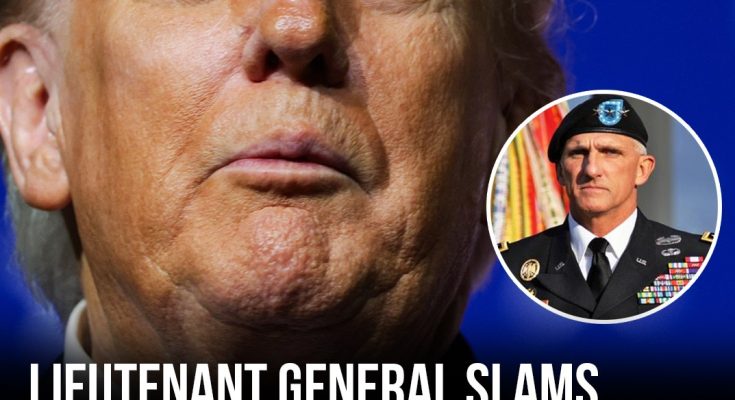On the morning of September 30, a large and unexpected order went out across the U.S. military command structure, summoning hundreds of generals and admirals from their posts worldwide to convene at Marine Corps Base Quantico in Virginia. The message was abrupt and offered little explanation, compelling senior officers who were actively deployed or stationed in Europe, the Middle East, Asia, and other strategic regions to abruptly rearrange their schedules and logistics. The sudden nature of the summons immediately raised eyebrows and concerns among military leadership.
Speculation spread rapidly through the ranks and defense circles that the meeting could herald significant personnel changes, budget cuts, or sweeping policy shifts — potentially disrupting ongoing operations at a time when global threats required steady, focused command. Adding a politically charged dimension to the gathering, it soon became clear that former President Donald Trump would be addressing the assembled crowd, which further fueled uncertainty and heightened tensions. The military leadership, accustomed to a clear chain of command and apolitical professionalism, was now confronted with a scenario that seemed to blur these boundaries in a highly public and unorthodox fashion.
When the event commenced, Secretary of War Pete Hegseth took center stage to outline his vision for the armed forces. His remarks were marked by a confrontational and blunt tone, directly challenging a number of recent policies and cultural shifts within the military. Hegseth launched a broadside against what he labeled “woke” culture infiltrating the ranks, singling out specific issues such as relaxed grooming standards, physical fitness requirements, and the integration of women into certain combat roles. His critique extended to senior officers, whom he disparagingly referred to as “overweight generals and admirals” based at the Pentagon. Hegseth dismissed the diversity and inclusion efforts enacted under the previous administration, framing them as distractions or even threats to military readiness and cohesion.
This speech immediately drew a firestorm of criticism from those in attendance and the wider defense community. Several officials who spoke off the record characterized the meeting as more of a spectacle or a political performance than a genuine military briefing. One senior defense official bluntly remarked that the event “felt more like a press conference than a briefing for generals,” emphasizing the disconnect between the format and the needs of military leaders tasked with real-world operational challenges. The official added that the entire message “could have been conveyed via email,” underscoring the perception that the face-to-face gathering was unnecessary and inefficient.

Beyond the content of the speech itself, a significant part of the controversy centered on the security and operational risks posed by concentrating such a high number of senior military leaders in one location at a publicly known time. This breach of typical operational security protocols drew sharp criticism from defense experts who warned that the gathering was a glaring vulnerability. One former senior defense official called the assembly “an inexcusable strategic risk,” lamenting that the event consumed precious time for leaders with urgent global responsibilities while delivering what he described as “an inane message of little merit.”
Trump’s remarks during the meeting added to the complexity of the event. Among his statements was a repetition of his infamous phrase about “two N words,” clarifying that the second word was “nuclear,” a line that had previously sparked controversy. His broader remarks were seen as erratic and disconnected, contributing to the uneasy atmosphere. However, it was not just the speeches that resonated but the reactions in the hours and days afterward, many of which unfolded behind the scenes but some emerged publicly.
One of the most notable responses came from retired Lieutenant General Mark Hertling, who had served as the commanding general of U.S. Army Europe and Seventh Army. Unlike many who remained silent or spoke privately, Hertling chose to speak openly and directly about the incident. He criticized Hegseth’s speech for publicly shaming the military force and crossing a line by pressuring leaders in ways that risked undermining their professional oaths. In an appearance on MSNBC, Hertling said that Trump appeared “rattled” by the negative reaction from the assembled officers. He predicted that commanders would now face the difficult challenge of disentangling legitimate, lawful orders from those that crossed ethical or legal boundaries.
Hertling acknowledged that certain components of Hegseth’s message — such as enforcing stricter fitness standards and addressing readiness shortfalls — were reasonable and actionable directives that commanders understood how to implement. However, he drew a clear distinction between these practical measures and the more problematic elements of the speech. For example, broad dismissals of women who had already met established military standards were inappropriate and counterproductive. Equally troubling were any suggestions or orders that might contravene legal or ethical norms. Hertling was unequivocal in asserting that military officers “will not execute illegal orders,” emphasizing the professionalism and integrity that underpin the armed forces.

The retired general also spoke about the palpable sense of embarrassment and frustration experienced by many officers who were present. This was not merely a personal feeling but a reflection of concern for their entire service branches, as the public rebuke was broadcast on camera, seemingly intended for public consumption rather than internal correction. Such public shaming, Hertling argued, risks damaging morale and undermining the cohesion and trust within the military ranks.
To explain the depth of the backlash, Hertling referred to a foundational leadership principle: “You praise in public and discipline in private.” The Quantico gathering violated this critical norm by reversing the practice, turning what should have been private, constructive feedback into a public spectacle. This inversion not only damaged morale but also created a wedge between the military institution and the American public it serves, eroding the mutual respect essential to a healthy civil-military relationship.
In the weeks following the event, the military community continued to grapple with the fallout. Conversations emerged about the appropriate role of politics in military affairs and the importance of preserving the apolitical, professional nature of the armed forces. Defense leaders stressed the necessity of maintaining clear ethical boundaries and upholding the dignity of military service members, especially during times of political polarization and public scrutiny.
Operationally, the meeting was widely viewed as a distraction at a time when U.S. forces face complex and evolving threats across multiple theaters, including strategic competition with China and Russia, ongoing counterterrorism missions, and emerging cybersecurity challenges. The time and resources devoted to the Quantico event could have arguably been better allocated to mission-critical activities.
The incident underscored the delicate and essential balance between civilian leadership and military professionalism, highlighting the risks when this balance is disrupted. Military leaders remain steadfast in their commitment to their constitutional oath, ethical conduct, and the welfare of their troops, even as they navigate an increasingly complex and politicized environment.
In summary, the September 30 gathering at Quantico stands as a cautionary example of how political messaging, when delivered insensitively and without regard for military culture and norms, can provoke internal division, operational risk, and public controversy. It serves as a reminder of the enduring importance of respect, professionalism, and clear communication within the nation’s armed forces and between its civilian and military leaders.
On the morning of September 30, a large and unexpected order went out across the U.S. military command structure, summoning hundreds of generals and admirals from their posts worldwide to convene at Marine Corps Base Quantico in Virginia. The message was abrupt and offered little explanation, compelling senior officers who were actively deployed or stationed in Europe, the Middle East, Asia, and other strategic regions to abruptly rearrange their schedules and logistics. The sudden nature of the summons immediately raised eyebrows and concerns among military leadership.
Speculation spread rapidly through the ranks and defense circles that the meeting could herald significant personnel changes, budget cuts, or sweeping policy shifts — potentially disrupting ongoing operations at a time when global threats required steady, focused command. Adding a politically charged dimension to the gathering, it soon became clear that former President Donald Trump would be addressing the assembled crowd, which further fueled uncertainty and heightened tensions. The military leadership, accustomed to a clear chain of command and apolitical professionalism, was now confronted with a scenario that seemed to blur these boundaries in a highly public and unorthodox fashion.
When the event commenced, Secretary of War Pete Hegseth took center stage to outline his vision for the armed forces. His remarks were marked by a confrontational and blunt tone, directly challenging a number of recent policies and cultural shifts within the military. Hegseth launched a broadside against what he labeled “woke” culture infiltrating the ranks, singling out specific issues such as relaxed grooming standards, physical fitness requirements, and the integration of women into certain combat roles. His critique extended to senior officers, whom he disparagingly referred to as “overweight generals and admirals” based at the Pentagon. Hegseth dismissed the diversity and inclusion efforts enacted under the previous administration, framing them as distractions or even threats to military readiness and cohesion.
This speech immediately drew a firestorm of criticism from those in attendance and the wider defense community. Several officials who spoke off the record characterized the meeting as more of a spectacle or a political performance than a genuine military briefing. One senior defense official bluntly remarked that the event “felt more like a press conference than a briefing for generals,” emphasizing the disconnect between the format and the needs of military leaders tasked with real-world operational challenges. The official added that the entire message “could have been conveyed via email,” underscoring the perception that the face-to-face gathering was unnecessary and inefficient.

Beyond the content of the speech itself, a significant part of the controversy centered on the security and operational risks posed by concentrating such a high number of senior military leaders in one location at a publicly known time. This breach of typical operational security protocols drew sharp criticism from defense experts who warned that the gathering was a glaring vulnerability. One former senior defense official called the assembly “an inexcusable strategic risk,” lamenting that the event consumed precious time for leaders with urgent global responsibilities while delivering what he described as “an inane message of little merit.”
Trump’s remarks during the meeting added to the complexity of the event. Among his statements was a repetition of his infamous phrase about “two N words,” clarifying that the second word was “nuclear,” a line that had previously sparked controversy. His broader remarks were seen as erratic and disconnected, contributing to the uneasy atmosphere. However, it was not just the speeches that resonated but the reactions in the hours and days afterward, many of which unfolded behind the scenes but some emerged publicly.
One of the most notable responses came from retired Lieutenant General Mark Hertling, who had served as the commanding general of U.S. Army Europe and Seventh Army. Unlike many who remained silent or spoke privately, Hertling chose to speak openly and directly about the incident. He criticized Hegseth’s speech for publicly shaming the military force and crossing a line by pressuring leaders in ways that risked undermining their professional oaths. In an appearance on MSNBC, Hertling said that Trump appeared “rattled” by the negative reaction from the assembled officers. He predicted that commanders would now face the difficult challenge of disentangling legitimate, lawful orders from those that crossed ethical or legal boundaries.
Hertling acknowledged that certain components of Hegseth’s message — such as enforcing stricter fitness standards and addressing readiness shortfalls — were reasonable and actionable directives that commanders understood how to implement. However, he drew a clear distinction between these practical measures and the more problematic elements of the speech. For example, broad dismissals of women who had already met established military standards were inappropriate and counterproductive. Equally troubling were any suggestions or orders that might contravene legal or ethical norms. Hertling was unequivocal in asserting that military officers “will not execute illegal orders,” emphasizing the professionalism and integrity that underpin the armed forces.

The retired general also spoke about the palpable sense of embarrassment and frustration experienced by many officers who were present. This was not merely a personal feeling but a reflection of concern for their entire service branches, as the public rebuke was broadcast on camera, seemingly intended for public consumption rather than internal correction. Such public shaming, Hertling argued, risks damaging morale and undermining the cohesion and trust within the military ranks.
To explain the depth of the backlash, Hertling referred to a foundational leadership principle: “You praise in public and discipline in private.” The Quantico gathering violated this critical norm by reversing the practice, turning what should have been private, constructive feedback into a public spectacle. This inversion not only damaged morale but also created a wedge between the military institution and the American public it serves, eroding the mutual respect essential to a healthy civil-military relationship.
In the weeks following the event, the military community continued to grapple with the fallout. Conversations emerged about the appropriate role of politics in military affairs and the importance of preserving the apolitical, professional nature of the armed forces. Defense leaders stressed the necessity of maintaining clear ethical boundaries and upholding the dignity of military service members, especially during times of political polarization and public scrutiny.
Operationally, the meeting was widely viewed as a distraction at a time when U.S. forces face complex and evolving threats across multiple theaters, including strategic competition with China and Russia, ongoing counterterrorism missions, and emerging cybersecurity challenges. The time and resources devoted to the Quantico event could have arguably been better allocated to mission-critical activities.
The incident underscored the delicate and essential balance between civilian leadership and military professionalism, highlighting the risks when this balance is disrupted. Military leaders remain steadfast in their commitment to their constitutional oath, ethical conduct, and the welfare of their troops, even as they navigate an increasingly complex and politicized environment.
In summary, the September 30 gathering at Quantico stands as a cautionary example of how political messaging, when delivered insensitively and without regard for military culture and norms, can provoke internal division, operational risk, and public controversy. It serves as a reminder of the enduring importance of respect, professionalism, and clear communication within the nation’s armed forces and between its civilian and military leaders.

